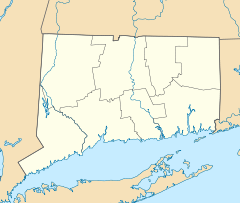- Downtown New London Historic District
-
Downtown New London Historic District
 New London Courthouse
New London CourthouseLocation: Roughly bounded by Captain's Walk, Bank, Tilley and Washington Sts. (original); Along Huntington, Washington and Jay Sts.; SW corner of Meridan and Gov. Winthrop Blvd.; along Bank and Sparyard Sts. (boundary increase); New London, Connecticut Coordinates: 41°21′10″N 72°5′47″W / 41.35278°N 72.09639°WCoordinates: 41°21′10″N 72°5′47″W / 41.35278°N 72.09639°W Area: 60 acres (24 ha) (original)
18 acres (7.3 ha) (increase)Built: 1790 Architect: Bishop,John; Multiple Architectural style: Late 19th And 20th Century Revivals, Greek Revival, Late Victorian Governing body: State NRHP Reference#: 79002665 and 88000070[1] Added to NRHP: April 13, 1979 (original)
February 18, 1988 (increase)The Downtown New London Historic District refers to 78 acres (0.32 km2) and 223 contributing buildings along the waterfront of New London, Connecticut, an area roughly bounded by the Captain's Walk, also known as State Street, to the Northeast, Bank Street to the Southeast, Tilley Street to the Southwest, and Washington Street to the Northwest. It was added to the US National Register of Historic Places in 1979, with 190 buildings and 60 acres (240,000 m2). The district was expanded in 1988 to include Huntington, Washington and Jay Streets, the Southwest corner of Meridian Street and Governor Winthrop Boulevard, and along Bank Street to Spar Yard Street, which added 18 acres (73,000 m2) and 33 buildings to the historic district.[1][2]
Running immediately along the Thames River is the area known as "The Bank". Once dominated by fishing wharves and tall ships, Bank Street is one of New London's oldest sections. After the burning of New London by the British under the command of Benedict Arnold in 1781, the waterfront was rebuilt and the roadway raised to accommodate additional development and larger ships. The Bank is now home to a number of restaurants, cafes and boutiques and is dotted with a handful of 18th century structures including Shaw Mansion (built 1753; Connecticut Navy Headquarters during the American Revolution) and Bukeley House (built 1796; the owner served with John Paul Jones); and 19th century buildings including the 1833 US Customs House, the oldest such building continuously operated in the United States and the site of the events surrounding the slave ship La Amistad.
Running through the Downtown Historic District is State Street, lined with 19th century buildings. Notable exceptions are the 1787 Court House at the head of State Street, the 1740 Timothy Green printing studio (off State and Green Streets) and the Nathan Hale School House (built in 1774).
Also in the downtown historic area is Green Street, just off State. Laid out officially in 1787, many of the buildings in this neighborhood date from 1760-1792 and survived the torch of Benedict Arnold. Eugene O'Neill's favorite watering spot, The Dutch (Dutch's Tavern) is here, housed in a 1760 building. The home at 79 Green, dating to around 1801, is known as The Richard Douglass House [3] a veteran of the American Revolution and still a private residence.
Also in the immediate area is the Starr Street District - a group of row houses built in the first two decades of the 1800s.
The district includes at least four separately NRHP-listed places:[1]
- New London Public Library
- New London Customhouse
- New London County Courthouse at 70 Hunting Street
- New London Railroad Station
References
- ^ a b c "National Register Information System". National Register of Historic Places. National Park Service. 2009-03-13. http://nrhp.focus.nps.gov/natreg/docs/All_Data.html.
- ^ [http://www.nr.nps.gov/nrloc1.htm[dead link] "National Register Information System"]. National Register of Historic Places. National Park Service. http://www.nr.nps.gov/nrloc1.htm[dead link]. Retrieved 2008-05-12.[dead link]
- ^ The Richard Douglass House
U.S. National Register of Historic Places Topics Lists by states Alabama • Alaska • Arizona • Arkansas • California • Colorado • Connecticut • Delaware • Florida • Georgia • Hawaii • Idaho • Illinois • Indiana • Iowa • Kansas • Kentucky • Louisiana • Maine • Maryland • Massachusetts • Michigan • Minnesota • Mississippi • Missouri • Montana • Nebraska • Nevada • New Hampshire • New Jersey • New Mexico • New York • North Carolina • North Dakota • Ohio • Oklahoma • Oregon • Pennsylvania • Rhode Island • South Carolina • South Dakota • Tennessee • Texas • Utah • Vermont • Virginia • Washington • West Virginia • Wisconsin • WyomingLists by territories Lists by associated states Other Categories:- NRHP articles with dead external links
- Historic districts in Connecticut
- New London, Connecticut
- Historic districts in New London County, Connecticut
Wikimedia Foundation. 2010.

